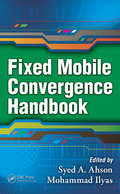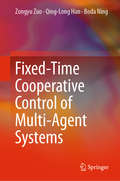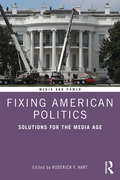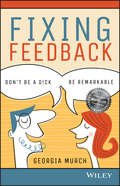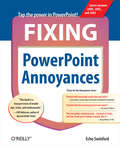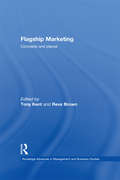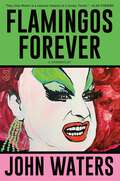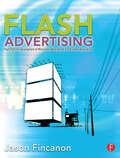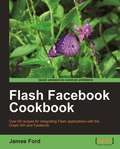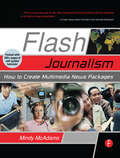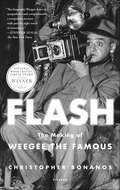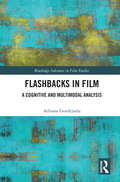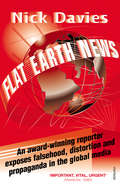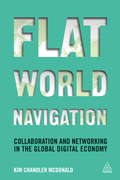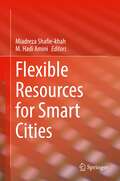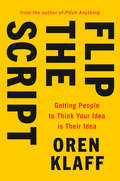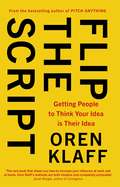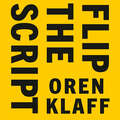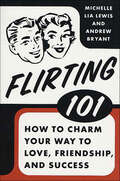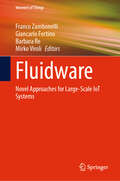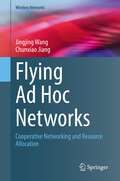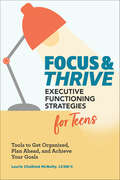- Table View
- List View
Five-Minute Activities for Business English
by Penny Ur Paul Emmerson Nick HamiltonThis comprehensive resource book contains an easy-to-use set of short activities essential for anyone teaching Business English. Reflecting real-life business activities such as emails, noisy telephone conversations, making excuses, negotiating, handling customer complaints and cultural awareness, Five-Minute Activities for Business English helps teachers mirror the pacey feel of the work environment. This book is also of interest to teachers of general English who are looking for stimulating skills-based activities in meaningful contexts and complements both tailored and coursebook-based materials. The four main areas covered are 'Business topics', 'Business communication skills', 'Language work' and 'Exploiting coursebooks'. These areas feature activities on various topics such as money, finance, meetings, negotiations, telephoning, management, marketing, etc.
Fixed Mobile Convergence Handbook
by Mohammad Ilyas Syed A. AhsonRequirements for next generation networks (NGNs) are fueling an architectural evolution. Service providers are obliged to give users access to content anytime, anyhow, anywhere, on any device. This requires a converged infrastructure in which users across multiple domains can be served through a single unified domain and all network services and business units can be consolidated on a single IP infrastructure. The Fixed Mobile Convergence Handbook is a comprehensive guide to the design, implementation, and management of converged cellular/WiFi wireless networks. This book discusses how FMC is transforming technologies as multimedia ceases to be passively consumed and unidirectional—and becomes increasingly mobile, personalized and interactive. This book also describes ways to ensure that networks remain cost-effective, scalable, reliable, and secure in the face of constant technological evolution. This material encapsulates the state of FMC, covering everything from basic concepts to research-grade material and future directions. Addressing a broad range of topics, the handbook consists of 16 chapters authored by 44 experts from around the world. Subjects include: Femtocell network technology and applications Deployment modes and interference avoidance Architecture for power efficiency Conversational quality and network planning Design of SIP-based mobility management protocols Highly respected in their field, the authors anticipate the key issues and problems that FMC presents—from application inception and deployment to system interconnection and Quality of Service (QoS). Ideal for professional mobile technology designers and/or planners, researchers (faculty members and graduate students), this book provides specific salient features and information that will guide innovation in the 21st century and beyond. Syed Ahson is a senior software design engineer with Microsoft. Previously, he was a senior staff software engineer with Motorola, where he was a leading contributor in the creation of several iDEN, CDMA, and GSM cellular phones. Dr. Mohammad Ilyas is associate dean for research and industry relations at the College of Engineering and Computer Science at Florida Atlantic University, Boca Raton. A consultant to several national and international organizations, Dr. Ilyas is a member of both the IEEE and ASEE.
Fixed-Time Cooperative Control of Multi-Agent Systems
by Qing-Long Han Zongyu Zuo Boda NingThis monograph presents new theories and methods for fixed-time cooperative control of multi-agent systems. Fundamental concepts of fixed-time stability and stabilization are introduced with insightful understanding. This book presents solutions for several problems of fixed-time cooperative control using systematic design methods. The book compares fixed-time cooperative control with asymptotic cooperative control, demonstrating how the former can achieve better closed-loop performance and disturbance rejection properties. It also discusses the differences from finite-time control, and shows how fixed-time cooperative control can produce the faster rate of convergence and provide an explicit estimate of the settling time independent of initial conditions. This monograph presents multiple applications of fixed-time control schemes, including to distributed optimization of multi-agent systems, making it useful to students, researchers and engineers alike.
Fixing American Politics: Solutions for the Media Age (Media and Power)
by Roderick P. HartFixing American Politics: Solutions for the Media Age brings together original chapters from 34 noted scholars from two disciplines – political science and communication – asked to identify the most pressing problems facing the American people and how they can be solved. Authors address the questions succinctly and directly, with their favored solutions featured in chapter titles that exhort and inspire. The book gives the reader much to think about and debate. Should news outlets be funded with public money rather than by private enterprise? Are the new social media a boon or a bane to political elections? Is the American past dead, or is it living once again? Do churchgoers and environmentalists have anything to discuss? Is the FCC doing its job? Can political ads be made less toxic? Should Fox News be "cancelled?" Should cancel cultures be cancelled? Can we become more civil to one another and, if so, how? Fixing American Politics poses all the best questions … and offers some concrete answers as well. This book is perfect for students, citizens, the media, and anyone concerned with contemporary challenges to civic life and discourse today.
Fixing Feedback
by Georgia MurchFeedback is broken -- here's how to fix it to create a highly engaged workplace with high performing leaders and employees Fixing Feedback is not just another management book -- it's a smart, refreshing, practical guide to feedback in the workplace. Everyone already knows how important feedback is, and we all know we should be giving it and receiving it regularly -- yet we still do it poorly or avoid it entirely. This book shows you how to do it right. You'll learn what exactly constitutes useful feedback, how to deliver it effectively, how to receive it gracefully and how to use it to strengthen yourself, your team and your business. You'll learn critical communication skills that you can put into practice today, and get on track to building a "feedback culture" that results in highly engaged, highly productive employees. The way you communicate dictates how you build relationships and make decisions. It's the difference between being remarkable and being a d!ck. Poor communication is a major force driving feedback into the ground, and it can be extremely costly for the company as a whole. This book shows you how to turn the ship around by making feedback a meaningful -- and welcome -- part of your everyday workflow and overall company culture. Understand "remarkable feedback", and how it changes people and workplaces Self-assess your communication style and gauge the impact it has on others Deliver meaningful feedback using a set of pragmatic tools and techniques Confront the personal issues that prevent you from effectively receiving feedback Learn what organisations need to drive to create a 'feedback culture' When organisations fail to grasp the importance of investing in their people effectively, employees disengage. Building a meaningful feedback culture, on the other hand, makes your organisation a place where people want to work, want to achieve and want to be the best. It's all about effective communication. Fixing Feedback provides no-nonsense guidance toward equipping your people to succeed.
Fixing Feedback: Don't Be A D!ck, Be Remarkable
by Georgia MurchFeedback is broken — here's how to fix it to create a highly engaged workplace with high performing leaders and employees Fixing Feedback is not just another management book — it's a smart, refreshing, practical guide to feedback in the workplace. Everyone already knows how important feedback is, and we all know we should be giving it and receiving it regularly — yet we still do it poorly or avoid it entirely. This book shows you how to do it right. You'll learn what exactly constitutes useful feedback, how to deliver it effectively, how to receive it gracefully and how to use it to strengthen yourself, your team and your business. You'll learn critical communication skills that you can put into practice today, and get on track to building a "feedback culture" that results in highly engaged, highly productive employees. The way you communicate dictates how you build relationships and make decisions. It's the difference between being remarkable and being a d!ck. Poor communication is a major force driving feedback into the ground, and it can be extremely costly for the company as a whole. This book shows you how to turn the ship around by making feedback a meaningful — and welcome — part of your everyday workflow and overall company culture. Understand "remarkable feedback", and how it changes people and workplaces Self-assess your communication style and gauge the impact it has on others Deliver meaningful feedback using a set of pragmatic tools and techniques Confront the personal issues that prevent you from effectively receiving feedback Learn what organisations need to drive to create a 'feedback culture' When organisations fail to grasp the importance of investing in their people effectively, employees disengage. Building a meaningful feedback culture, on the other hand, makes your organisation a place where people want to work, want to achieve and want to be the best. It's all about effective communication. Fixing Feedback provides no-nonsense guidance toward equipping your people to succeed.
Fixing PowerPoint Annoyances: How to Fix the Most Annoying Things About Your Favorite Presentation Program (Annoyances)
by Echo SwinfordIf you're vexed and perplexed by PowerPoint, pick up a copy of Fixing PowerPoint Annoyances . This funny, and often opinionated, guide is chock full of tools and techniques for eliminating all the problems that drive audiences and presenters crazy. There's nothing more discouraging than an unresponsive audience--or worse, one that snickers at your slides. And there's nothing more maddening than technical glitches that turn your carefully planned slide show into a car wreck. Envious when you see other presenters effectively use nifty features that you've never been able to get to work right? Suffer no more! Fixing PowerPoint Annoyances by Microsoft PowerPoint MVP Echo Swinford rides to the rescue. Microsoft PowerPoint is the most popular presentation software on the planet, with an estimated 30 million presentations given each day. So no matter how frustrated you get, you're not about to chuck the program in the Recycle Bin. Fixing PowerPoint Annoyances , presents smart solutions to a variety of all-too-familiar, real-world annoyances. The book is divided into big categories, with annoyances grouped by topic. You can read it cover to cover or simply jump to the chapter or section most relevant to you. Inside its pages you'll learn how to create your own templates, work with multiple masters and slide layouts, and take advantage of various alignment and formatting tools. You'll also learn how to import Excel data; insert graphics, PDF, and Word content; create, edit, and format organization charts and diagrams; use action settings and hyperlinks to jump to other slides; and add sound, video, and other types of multimedia to spark up your presentations. Entertaining and informative, Fixing PowerPoint Annoyances is filled with humorous illustrations and packed with sidebars, tips, and tricks, as well as links to cool resources on the Web.
Flagship Marketing: Concepts and places (Routledge Advances in Management and Business Studies)
by Tony Kent Reva BrownFlagships are the physical apogee of consumerism, places where brand experiences are most defined and interactions with consumers are highly refined. This book marks the first comprehensive study of the concept of the flagship, bringing together a range of scholarly insights from the field, covering issues such as consumerism, areas of consumption and experimental marketing theory and practise. The ways in which flagship projects communicate brand values, both externally and internally, form an important part of this book, and provide new perspectives on late twentieth century commercial and cultural policy and practice. Kent and Brown offer a truly interdisciplinary approach to the concept, offering a variety of perspectives on the debates surrounding flagship function and its role as a place of consumption. Chapters focus on the development of prestigious stores, hotels and arts and cultural centres, as showcases for branded experiences and products and as demonstrations of commercial and public policy. Cases and examples include The Eden Project in the UK, automotive showrooms in Germany, hotels in Dubai and Las Vegas, and Vienna's cultural quarter. Theoretical discussion explores the tensions between costs and profitability, conspicuous consumption and the sustainability of iconic forms. The book enables readers to explore the flagship concept from different perspectives, and while a marketing approach predominates, it provides a disciplinary challenge which will open up new ways of understanding the concept.
Flamingos Forever: A Screenplay
by John WatersOne part of John Waters’ iconic Trash Trilogy, Flamingos Forever is a dark-comedy screenplay about a drag queen trying to retain her title of “Filthiest Person in the World.”Fifteen years after the events of Pink Flamingos, Babs Johnson returns to Baltimore from a life spent largely in bus station lavatories, only to find that she once again has to fight for the right to claim the title of “World’s Filthiest Person.” Her nemesis Connie Marble’s sister, Vera Venninger, and her necrophiliac husband, Wilbur, are in her way. So begins a new battle of filth.This raucous, filthy—and essential!—volume in John Waters’ oeuvre never made it to the screen, so this is readers’ and his legions of fans’ one chance to see how this ghastly and irreverent saga meets its end!
Flash Advertising: Flash Platform Development of Microsites, Advergames and Branded Applications
by Jason FincanonCreate awe-inspiring, mind-blowing Flash ads, microsites, advergames, and branded applications that engage consumers and demonstrate their worth to clients. Creating Flash Advertising delivers the nuts and bolts of the development process from initial design conception to ad completion. You'll learn the best practices for: Mastering the myriad of ad specs, deadlines, quality and version control issues and creating ads that balance campaign goals with design constraints. Preparing and building ads with team and QC standards. Using forms and data in ads without file bloatt. File optimization techniques for swf files 3rd party rich media technologies that transcend the 30k banner. Integrating video into sites and banners. Social media applications. Trafficking and tracking ads for impressions, interactions, clicks, and conversions.Using ActionScript to save development time and implement team standards. Published projects developed with the practices and AS code presented in the book are available on the companion website http://www.flashadbook.com
Flash Facebook Cookbook
by James FordWritten in a cookbook style, this book offers solutions using a recipe-based approach. Each recipe contains step-by-step instructions followed by an analysis of what was done in each task and other useful information. This Cookbook is targeted towards those with at least a basic understanding of the Flash Builder IDE and the Flex framework. No prior knowledge of the Facebook APIs is assumed or required. If you want to start building Flash Facebook apps quickly and effectively this is the book for you.
Flash Journalism: How to Create Multimedia News Packages
by Mindy McAdamsThis book will assist journalists and Flash developers who are working together to bring video, audio, still photos, and animated graphics together into one complete Web-based package.This book is not just another Flash book because it focuses on the need of journalists to tell an accurate story and provide accurate graphics. This book will illustrate how to animate graphics such as maps, illustrations, and diagrams using Flash. It will show journalists how to integrate high-quality photos and audio interviews into a complete news package for the Web.Each lesson in the book is followed by a learning summary so that journalists can review the skills they have acquired along the way. In addition, the book's six case studies will allow readers to study the characteristics of news packages created with Flash by journalists and Web developers at The Washington Post, MSNBC.com, and Canadian and European news organizations.
Flash: The Making of Weegee the Famous
by Christopher BonanosWinner of the National Book Critics Circle AwardThe first comprehensive biography of Weegee—photographer, “psychic,” ultimate New Yorker—from Christopher Bonanos, author of Instant: The Story of Polaroid.Arthur Fellig’s ability to arrive at a crime scene just as the cops did was so uncanny that he renamed himself “Weegee,” claiming that he functioned as a human Ouija board. Weegee documented better than any other photographer the crime, grit, and complex humanity of midcentury New York City. In Flash, we get a portrait not only of the man (both flawed and deeply talented, with generous appetites for publicity, women, and hot pastrami) but also of the fascinating time and place that he occupied.From self-taught immigrant kid to newshound to art-world darling to latter-day caricature—moving from the dangerous streets of New York City to the celebrity culture of Los Angeles and then to Europe for a quixotic late phase of experimental photography and filmmaking—Weegee lived a life just as worthy of documentation as the scenes he captured. With Flash, we have an unprecedented and ultimately moving view of the man now regarded as an innovator and a pioneer, an artist as well as a newsman, whose photographs are among most powerful images of urban existence ever made.
Flashbacks in Film: A Cognitive and Multimodal Analysis (Routledge Advances in Film Studies)
by Adriana GordejuelaFlashbacks in Film examines fi lm fl ashback as a rich multimodal narrative device, analyzing the cognitive underpinnings of fi lm fl ashbacks and the mechanisms that lead viewers to successfully comprehend them. Combining a cognitive fi lm theory approach with the theoretical framework proposed by blending theory, which claims that human beings’ general ability for conceptual integration underlies most of our daily activities, this book argues that fl ashbacks make sense to the viewer, as they are specifi cally designed for the viewer’s cognitive understanding. Through a mixture of analysis and dozens of case studies, this book demonstrates that successful fi lm fl ashbacks appeal to the spectator’s natural perceptual and cognitive abilities, which spectators exercise daily. This book will serve as a valuable resource for scholars interested in film studies, media studies, and cognitive linguistics.
Flat Earth News: An Award-winning Reporter Exposes Falsehood, Distortion and Propaganda in the Global Media
by Nick DaviesDoes ‘fake news’ really exist? Find out from the ultimate insider.After years of working as a respected journalist, Nick Davies, in this shocking exposé, reveals what really goes on behind the scenes of this contentious industry. From a prestigious newspaper that allowed intelligence agencies to plant fiction in its columns, to the newsroom that routinely rejected stories due to racial bias, to the number of papers that accepted cash bribes. Gripping, thought-provoking and revelatory, this is an insider’s look at one of the most tainted professions.‘Meticulous, fair-minded and utterly gripping’ Telegraph‘Powerful and timely...his analysis is fair, meticulously researched and fascinating’ Observer
Flat World Navigation
by Kim Chandler McdonaldFlat World Navigation introduces the new future of work in the 'flattened world' of the new digital attention-based economy, where real connections can be made in seconds across departments, businesses, cultures and countries. Combining the best elements of networking, social media outreach and collaborative techniques, flat world navigation is an essential capability to build and maintain relationships between colleagues, customers and partners. Employees who can transform themselves into flat world navigators, experts in mediating these powerful relationships and bringing the customer into the conversation, will mean the difference between success and failure in business. Flat World Navigation includes exclusive insights and interviews with international business leaders who successfully use flat world navigation skills, such as the Emmy-winning former NBC and Wall Street Journal reporter Kare Anderson, Sandy Carter at IBM, Gordon Feller at CISCO Systems, Aria Finger at DoSomething.org, Louise Guido at ChangeCorp, Jeffrey A. Finkle at the International Economic Development Council and Carolyn Lawrence, CEO of Women of Influence. This book is grounded in real-world experience with insights and advice to build your skills base and empower the next generation of business people. Additionally, it is of great use to business owners and managers looking to effectively leverage the skills of these flat world navigators, whose critical role brings attention to ideas, products and services and, as such, must be part of a successful business strategy.
Flexible Resources for Smart Cities
by M. Hadi Amini Miadreza Shafie-KhahThis book paves the road for researchers from various areas of engineering working in the realm of smart cities to discuss the intersections in these areas when it comes to infrastructure and its flexibility. The authors lay out models, algorithms and frameworks related to the ‘smartness’ in the future smart cities. In particular, manufacturing firms, electric generation, transmission and distribution utilities, hardware and software computer companies, automation and control manufacturing firms, and other industries will be able to use this book to enhance their energy operations, improve their comfort and privacy, as well as to increase the benefit from the electrical system. The book pertains to researchers, professionals, and R&D in an array of industries.
Flip the Script: Getting People to Think Your Idea Is Their Idea
by Oren KlaffTHE BESTSELLING AUTHOR OF PITCH ANYTHING IS BACK TO FLIP YOUR ENTIRE APPROACH TO PERSUASION.Is there anything worse than a high-pressure salesperson pushing you to say "yes" (then sign on the dotted line) before you're ready?If there's one lesson Oren Klaff has learned over decades of pitching, presenting, and closing long-shot, high-stakes deals, it's that people are sick of being marketed and sold to. Most of all, they hate being told what to think. The more you push them, the more they resist.What people love, however, is coming up with a great idea on their own, even if it's the idea you were guiding them to have all along. Often, the only way to get someone to sign is to make them feel like they're smarter than you.That's why Oren is throwing out the old playbook on persuasion. Instead, he'll show you a new approach that works on this simple insight: Everyone trusts their own ideas. If, rather than pushing your idea on your buyer, you can guide them to discover it on their own, they'll believe it, trust it, and get excited about it. Then they'll buy in and feel good about the chance to work with you.That might sound easier said than done, but Oren has taught thousands of people how to do it with a series of simple steps that anyone can follow in any situation.And as you'll see in this book, Oren has been in a lot of different situations.He'll show you how he got a billionaire to take him seriously, how he got a venture capital firm to cough up capital, and how he made a skeptical Swiss banker see him as an expert in banking. He'll even show you how to become so compelling that buyers are even more attracted to you than to your product. These days, it's not enough to make a great pitch.To get attention, create trust, and close the deal, you need to flip the script.
Flip the Script: Getting People to Think Your Idea is Their Idea
by Oren KlaffThis book will change the way you think about persuasion, and have you closing deals in no time.These days, it's just not enough to make a great pitch. Over decades of being marketed, pitched, sold (and lied) to, we've grown resistant to sales persuasion. The moment we feel pressured to buy, we pull away. And if we're told what to think, our defences go up. That's why Oren Klaff, bestselling author of Pitch Anything, has devised a new approach to persuasion based on a simple insight: everyone trusts their own ideas. Instead of pushing your idea on your buyer, guide them to discover it on their own and they will get excited about it. They'll buy in and feel good about the chance to work with you. In Flip the Script, Klaff breaks down this insight into a series of actionable steps.You will learn how to:*Achieve Status Alignment: Use a status tip-off, a strategically placed remark that identifies you as an insider who can relate to your client's concerns.*Close the Certainty Gap: Allay your buyer's fears about going into business with you by delivering a flash roll, proving your expertise in the domain.*Present Your Idea as Plain Vanilla: Don't overhype your product as a first-of-its-kind solution. The more you emphasise the familiar, reliable elements of your product, the easier you make it for your buyer to say yes.Packed with examples of the long-shot, often hilarious deals that Klaff has pulled off over the years, Flip the Script is the most entertaining, informative masterclass in dealmaking you'll find anywhere. It will transform your approach to pitching, leaving you fully prepared to raise money, seal deals and keep your cool in the toughest business situations.
Flip the Script: Getting People to Think Your Idea is Their Idea
by Oren KlaffThis book will change the way you think about persuasion, and have you closing deals in no time.These days, it's just not enough to make a great pitch. Over decades of being marketed, pitched, sold (and lied) to, we've grown resistant to sales persuasion. The moment we feel pressured to buy, we pull away. And if we're told what to think, our defences go up. That's why Oren Klaff, bestselling author of Pitch Anything, has devised a new approach to persuasion based on a simple insight: everyone trusts their own ideas. Instead of pushing your idea on your buyer, guide them to discover it on their own and they will get excited about it. They'll buy in and feel good about the chance to work with you. In Flip the Script, Klaff breaks down this insight into a series of actionable steps.You will learn how to:*Achieve Status Alignment: Use a status tip-off, a strategically placed remark that identifies you as an insider who can relate to your client's concerns.*Close the Certainty Gap: Allay your buyer's fears about going into business with you by delivering a flash roll, proving your expertise in the domain.*Present Your Idea as Plain Vanilla: Don't overhype your product as a first-of-its-kind solution. The more you emphasise the familiar, reliable elements of your product, the easier you make it for your buyer to say yes.Packed with examples of the long-shot, often hilarious deals that Klaff has pulled off over the years, Flip the Script is the most entertaining, informative masterclass in dealmaking you'll find anywhere. It will transform your approach to pitching, leaving you fully prepared to raise money, seal deals and keep your cool in the toughest business situations.
Flirting 101: How to Charm Your Way to Love, Friendship, and Success
by Michelle Lia Lewis Andrew BryantEvery party has a stand-out - a guy or gal who breezes into a room and instantly attracts everyone's attention. It's not always about looks or money, so what's their secret? It's all about flirting! A good flirt knows how to make anyone around them feel good, and that's a very powerful skill. Luckily, it is a skill that can be learned. FLIRTING 101 will show you how to:-Discover your inner flirt -Increase your self-confidence -Take advantage of non-verbal communication-Overcome your fear of rejectionAnd much more!Whether you want to attract a life partner, improve business, or just have a little fun, this book is packed with useful tips, stories, practical exercises, and quizzes to help you transform into the most fabulous flirt you can be.
Fluctuation-Induced Network Control and Learning: Applying the Yuragi Principle of Brain and Biological Systems
by Masayuki Murata Kenji LeibnitzFrom theory to application, this book presents research on biologically and brain-inspired networking and machine learning based on Yuragi, which is the Japanese term describing the noise or fluctuations that are inherently used to control the dynamics of a system. The Yuragi mechanism can be found in various biological contexts, such as in gene expression dynamics, molecular motors in muscles, or the visual recognition process in the brain. Unlike conventional network protocols that are usually designed to operate under controlled conditions with a predefined set of rules, the probabilistic behavior of Yuragi-based control permits the system to adapt to unknown situations in a distributed and self-organized manner leading to a higher scalability and robustness.The book consists of two parts. Part 1 provides in four chapters an introduction to the biological background of the Yuragi concept as well as how these are applied to networking problems. Part 2 provides additional contributions that extend the original Yuragi concept to a Bayesian attractor model from human perceptual decision making. In the six chapters of the second part, applications to various fields in information network control and artificial intelligence are presented, ranging from virtual network reconfigurations, a software-defined Internet of Things, and low-power wide-area networks.This book will benefit those working in the fields of information networks, distributed systems, and machine learning who seek new design mechanisms for controlling large-scale dynamically changing systems.
Fluidware: Novel Approaches for Large-Scale IoT Systems (Internet of Things)
by Giancarlo Fortino Franco Zambonelli Mirko Viroli Barbara ReThis book provides an overview of the many approaches that can adopted for programming and deploying highly-adaptive and large-scale IoT systems, with a specific focus on the key results achieved within the Fluidware research project. The authors start by presenting Fluidware, which develops a novel programming model for IoT services and applications, along with the associated and robust large-scale IoT services and applications. Starting from previous findings in the areas of field-based coordination, collective adaptive systems, stream computing and aggregate computing, the authors address the complexity of building modern, large-scale IoT systems, by a full-fledged engineering approach revolving around a new notion of distributed programming. The authors show how the key innovative idea of Fluidware is to abstract collectives of devices of the IoT fabric as sources, digesters, and targets of distributed "flows" of contextualized events, carrying information about data produced and actuating commands. The book is divided into three parts: (i) the first part is a general introduction to the Fluidware ideas and to the key problems associated with programming IoT systems, (ii) the second part presents the key results achieved within the Fluidware project; (iii) the third part identified open challenges and research directions.
Flying Ad Hoc Networks: Cooperative Networking and Resource Allocation (Wireless Networks)
by Chunxiao Jiang Jingjing WangRelying on unmanned autonomous flight control programs, unmanned aerial vehicles (UAVs) equipped with radio communication devices have been actively developed around the world. Given their low cost, flexible maneuvering and unmanned operation, UAVs have been widely used in both civilian operations and military missions, including environmental monitoring, emergency communications, express distribution, even military surveillance and attacks, for example. Given that a range of standards and protocols used in terrestrial wireless networks are not applicable to UAV networks, and that some practical constraints such as battery power and no-fly zone hinder the maneuverability capability of a single UAV, we need to explore advanced communication and networking theories and methods for the sake of supporting future ultra-reliable and low-latency applications. Typically, the full potential of UAV network’s functionalities can be tapped with the aid of the cooperation of multiple drones relying on their ad hoc networking, in-network communications and coordinated control. Furthermore, some swarm intelligence models and algorithms conceived for dynamic negotiation, path programming, formation flight and task assignment of multiple cooperative drones are also beneficial in terms of extending UAV’s functionalities and coverage, as well as of increasing their efficiency. We call the networking and cooperation of multiple drones as the terminology ‘flying ad hoc network (FANET)’, and there indeed are numerous new challenges to be overcome before the idespread of so-called heterogeneous FANETs. In this book, we examine a range of technical issues in FANETs, from physical-layer channel modeling to MAC-layer resource allocation, while also introducing readers to UAV aided mobile edge computing techniques.
Focus & Thrive: Tools to Get Organized, Plan Ahead, and Achieve Your Goals
by Laurie Chaikind McNultyConceive, believe, achieve—strategies to help teens ages 13 to 17 build executive functioning skillsExecutive functioning is the way we manage our daily lives, including organization, planning ahead, and getting started on important tasks. These abilities may be easier for some and more challenging for others to master. Focus and Thrive is full of practical tools to help teens uncover strengths and develop executive functioning skills like staying focused, getting organized, making plans, and managing time.From creating a checklist to maintaining a daily routine, this supportive executive functioning guide can help you feel more confident in finishing everyday tasks at school, at home, at work, and beyond. Ultimately, this straightforward approach to building executive function skills will put you on the path to achieving your goals with focus and determination.This executive functioning book for teens features:Step-by-step solutions—Discover simple strategies to tackle difficult situations you face everyday.Easy "life hacks"—Learn how you can overcome challenges like forgetting your belongings, communicating your needs, and more.Powerful tools—Find a system that works for you with graphic organizers and sample checklists you can copy and reuse.Develop better organization and time-management skills with this executive functioning resource for teens.

